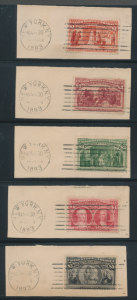 The story of the 1893 Columbian Exposition issue is well known. World’s Fairs, which was what the Columbian Exposition was, were a big thing until the advent of television and theme parks (in fact the last great US World Fair, the 1964 World’s fair in New York, had the first version of the “It’s a Small World” ride that was incorporated into Disney world). World’s fairs were a chance to see the latest innovations, and companies and nations vied with presentations to awe and impress. In 1893 the United States Post Office wanted to do just that, and as part of their exhibit they issued a new set of stamps commemorating Columbus’ discovery of the new world. It was a sixteen stamp set, well designed and well printed, and the Post Office thought that collectors would be delighted. It wasn’t the last time the Post Office got this wrong.
The story of the 1893 Columbian Exposition issue is well known. World’s Fairs, which was what the Columbian Exposition was, were a big thing until the advent of television and theme parks (in fact the last great US World Fair, the 1964 World’s fair in New York, had the first version of the “It’s a Small World” ride that was incorporated into Disney world). World’s fairs were a chance to see the latest innovations, and companies and nations vied with presentations to awe and impress. In 1893 the United States Post Office wanted to do just that, and as part of their exhibit they issued a new set of stamps commemorating Columbus’ discovery of the new world. It was a sixteen stamp set, well designed and well printed, and the Post Office thought that collectors would be delighted. It wasn’t the last time the Post Office got this wrong.Complaints ranged from the number of different stamps in the set to the designs, which are mostly frame with very small centers where the action was. But most of all collectors complained about the face value- $16.34. That was a lot of money in 1893. The average daily wage then was a bit over $1.50 so an average person needed to work ten days to afford a set. As the average daily wage now is over $120 per day, it would be like a set of stamps with a face value of over $1,200. Needless to say, collectors were unenthused. There was little call for the higher values for postal use and sales languished before the set was withdrawn and the unsold remainders destroyed.
Here’s the follow up: Dealer’s had bought quantities of the higher values hoping that collectors would come around and start to want them. They didn’t for years. To recoup their costs, dealer started using dollar value Columbians on controlled mail schemes (perfectly legal-here’s how it works- Dealer A needs to send a Registered package to Dealer B-he uses dollar value Columbians on the package. Dealer B returns the used stamps. Dealer A get his postage value out of the stamps plus the value of the used stamps which on high value Columbians is about half the value of mint). With the lack of true postal need for dollar value Columbian and dealer hoarding of high values in expectation of a price increase that never happened, very few of these stamps were used contemporaneously with nearly all used stamps having later cancels. You know the rest. Because there are only a handful of dollar values with 1893 cancellations that is what collectors want.
